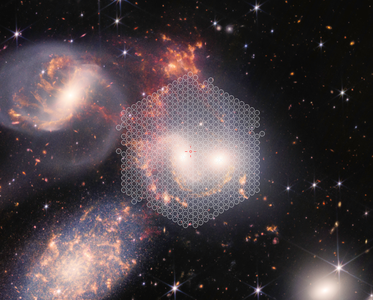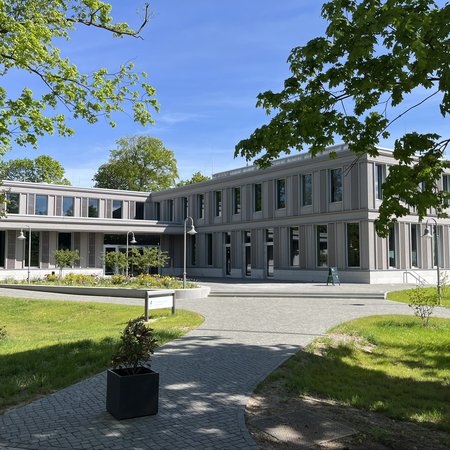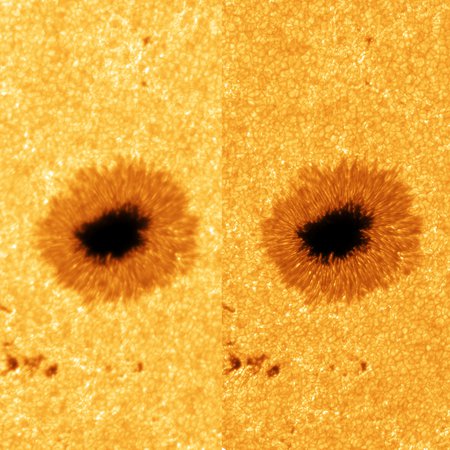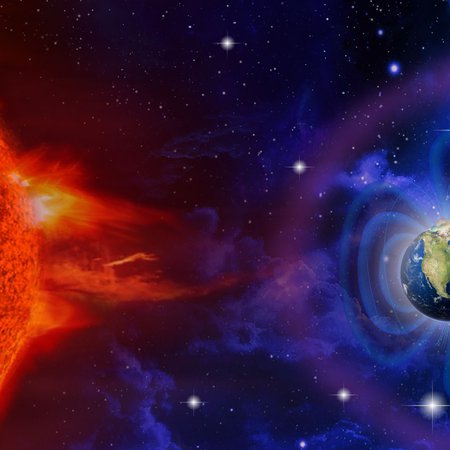New instrument analyses the heart of a galaxy group
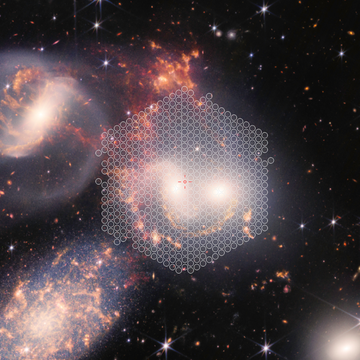
A JWST image of Stephan's Quintet overlayed with the WEAVE LIFU. The LIFU gathers light from 547 points on the sky for analysis by the WEAVE spectrograph (each circle indicates an optical fibre 2.6 arcseconds in diameter). The observation provides physical information from each separate region of each galaxy as well as the space in between.
Credit: NASA, ESA, CSA, STScI (background image); Aladin (overlay with fibres)A new instrument, WEAVE, at the William Herschel Telescope on La Palma, an island of the Canaries, has seen first light. It analysed the light of a pair of galaxies 280 million light years away from Earth. The Leibniz Institute for Astrophysics Potsdam (AIP) is one of the project's partners and AIP scientists will get access to its excellent data.
The new instrument WEAVE – WHT Enhanced Area Velocity Explorer is a powerful, next-generation multi-fibre spectrograph on the Wilhelm Herschel Telescope (WHT) at the Observatorio del Roque de los Muchachos on the island La Palma. It analyses the light of hundreds to thousands of celestial objects at the same time by using optical fibres for gathering and passing it to a spectrograph that separates the light into its different wavelengths or colours. Such spectra reveal useful scientific information, e.g. the speed of the object observed, the atoms it is made of and its temperature. If an image tells us what an astronomical object looks like, its spectrum tells us what it is.
First-light observations with WEAVE were carried out with the large integral-field unit (LIFU) fibre bundle, one of WEAVE's three fibre systems. The team observed two galaxies in the heart of Stephan’s Quintet, a group of five interacting galaxies 280 million light-years from Earth in the constellation Pegasus.
Professor Gavin Dalton, WEAVE Principal Investigator, University of Oxford and STFC RAL Space, comments: “The wealth of complexity revealed in this way by a single detailed observation of this pair of nearby galaxies provides insights into the interpretation of the many millions of spectra that WEAVE will obtain from galaxies in the distant universe and provides an excellent illustration of the power and flexibility of the WEAVE facility.”
The WEAVE LIFU measured separate spectra for 547 different regions in and around the two galaxies, recording the colours of their light from the ultraviolet to the near-infrared. These spectra reveal what types of stars the galaxies contain, the motions of stars and gas, the chemical composition of the stars, the temperatures and densities of the gas clouds, and more. This data will help astronomers learn how galaxy collisions transform the galaxies in the group.
Over 500 astronomers from across Europe have organized eight major surveys for WEAVE, covering studies of stellar evolution, Milky Way science, galaxy evolution and cosmology. WEAVE will study galaxies near and far to learn the history of their growth, and will obtain millions of spectra of stars in the Milky Way.
AIP scientists will contribute to the scientific exploitation of the WEAVE data. “The WEAVE large integral-field unit will allow us to study the dynamics of galaxies in unprecedented detail. We will build on experience we have acquired with previous and ongoing projects, such as CALIFA and MUSE. The wide-field and high spectral resolution offered by WEAVE allow access to the motions of stars in galaxy discs and in galaxy interactions in a way that was not possible before,” says Dr C. Jakob Walcher, project lead for WEAVE at AIP. AIP scientist Dr Marica Valentini adds: “This event foreshadows the advent of the WEAVE multi-object spectroscopy mode, which will allow us to observe many millions of stars in our Galaxy. As WEAVE observes the northern skies, it will be ideally complemented by the AIP-led 4MOST instrument, which will target the southern hemisphere. Together, these instruments will unravel the evolutionary history of our own Milky Way in incredible detail and breadth.” Marica Valentini is a leading member of the cooperation group between 4MOST and WEAVE. This group facilitates the homogenization of their catalogues together with SDSS-V and DESI – an example of broad-based collaboration for a wide scope.
Further information
ING press release with more images
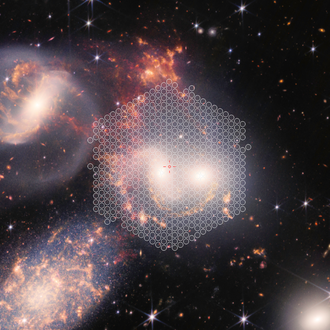
A JWST image of Stephan's Quintet overlayed with the WEAVE LIFU. The LIFU gathers light from 547 points on the sky for analysis by the WEAVE spectrograph (each circle indicates an optical fibre 2.6 arcseconds in diameter). The observation provides physical information from each separate region of each galaxy as well as the space in between.
Credit: NASA, ESA, CSA, STScI (background image); Aladin (overlay with fibres)A new instrument, WEAVE, at the William Herschel Telescope on La Palma, an island of the Canaries, has seen first light. It analysed the light of a pair of galaxies 280 million light years away from Earth. The Leibniz Institute for Astrophysics Potsdam (AIP) is one of the project's partners and AIP scientists will get access to its excellent data.
The new instrument WEAVE – WHT Enhanced Area Velocity Explorer is a powerful, next-generation multi-fibre spectrograph on the Wilhelm Herschel Telescope (WHT) at the Observatorio del Roque de los Muchachos on the island La Palma. It analyses the light of hundreds to thousands of celestial objects at the same time by using optical fibres for gathering and passing it to a spectrograph that separates the light into its different wavelengths or colours. Such spectra reveal useful scientific information, e.g. the speed of the object observed, the atoms it is made of and its temperature. If an image tells us what an astronomical object looks like, its spectrum tells us what it is.
First-light observations with WEAVE were carried out with the large integral-field unit (LIFU) fibre bundle, one of WEAVE's three fibre systems. The team observed two galaxies in the heart of Stephan’s Quintet, a group of five interacting galaxies 280 million light-years from Earth in the constellation Pegasus.
Professor Gavin Dalton, WEAVE Principal Investigator, University of Oxford and STFC RAL Space, comments: “The wealth of complexity revealed in this way by a single detailed observation of this pair of nearby galaxies provides insights into the interpretation of the many millions of spectra that WEAVE will obtain from galaxies in the distant universe and provides an excellent illustration of the power and flexibility of the WEAVE facility.”
The WEAVE LIFU measured separate spectra for 547 different regions in and around the two galaxies, recording the colours of their light from the ultraviolet to the near-infrared. These spectra reveal what types of stars the galaxies contain, the motions of stars and gas, the chemical composition of the stars, the temperatures and densities of the gas clouds, and more. This data will help astronomers learn how galaxy collisions transform the galaxies in the group.
Over 500 astronomers from across Europe have organized eight major surveys for WEAVE, covering studies of stellar evolution, Milky Way science, galaxy evolution and cosmology. WEAVE will study galaxies near and far to learn the history of their growth, and will obtain millions of spectra of stars in the Milky Way.
AIP scientists will contribute to the scientific exploitation of the WEAVE data. “The WEAVE large integral-field unit will allow us to study the dynamics of galaxies in unprecedented detail. We will build on experience we have acquired with previous and ongoing projects, such as CALIFA and MUSE. The wide-field and high spectral resolution offered by WEAVE allow access to the motions of stars in galaxy discs and in galaxy interactions in a way that was not possible before,” says Dr C. Jakob Walcher, project lead for WEAVE at AIP. AIP scientist Dr Marica Valentini adds: “This event foreshadows the advent of the WEAVE multi-object spectroscopy mode, which will allow us to observe many millions of stars in our Galaxy. As WEAVE observes the northern skies, it will be ideally complemented by the AIP-led 4MOST instrument, which will target the southern hemisphere. Together, these instruments will unravel the evolutionary history of our own Milky Way in incredible detail and breadth.” Marica Valentini is a leading member of the cooperation group between 4MOST and WEAVE. This group facilitates the homogenization of their catalogues together with SDSS-V and DESI – an example of broad-based collaboration for a wide scope.
Further information
ING press release with more images
Images
A JWST image of Stephan's Quintet overlayed with the WEAVE LIFU. The LIFU gathers light from 547 points on the sky for analysis by the WEAVE spectrograph (each circle indicates an optical fibre 2.6 arcseconds in diameter). The observation provides physical information from each separate region of each galaxy as well as the space in between.
